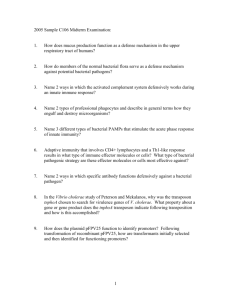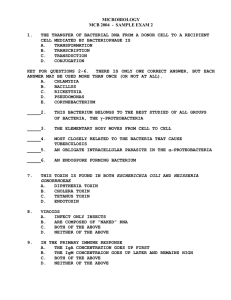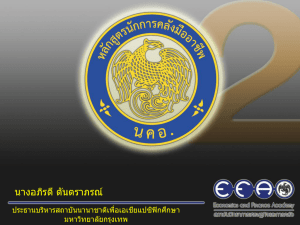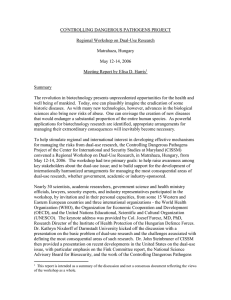nixdorff_presentation.ppt (672Kb)
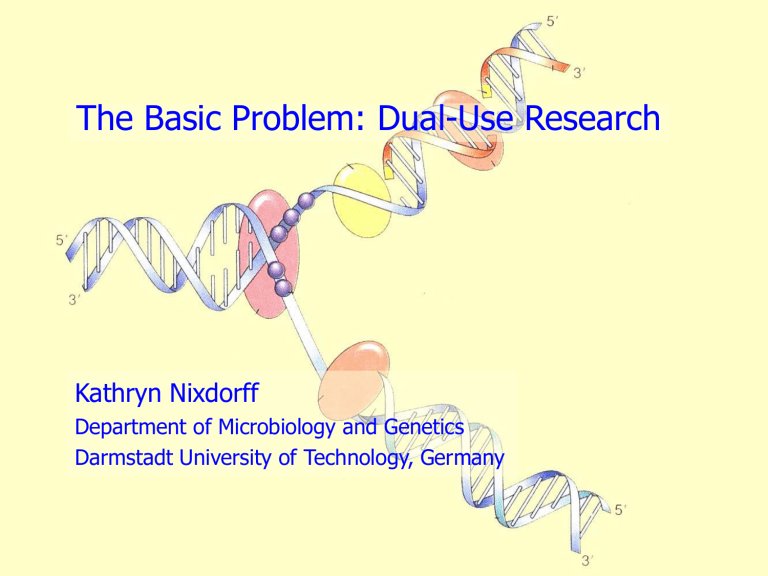
The Basic Problem: Dual-Use Research
Kathryn Nixdorff
Department of Microbiology and Genetics
Darmstadt University of Technology, Germany
1
What is dual-use research?
What are the challenges associated with defining the most consequential areas of dual-use research?
What are the implications for individual scientists and their work?
2
What is dual-use research?
What are the challenges associated with defining the most consequential areas of dual-use research?
What are the implications for individual scientists and their work?
3
Dual-Use Research:
Research that can have both military and civilian applications
NSABB : Legitimate research that could be misused to threaten public health or national security
Need to identify research as dual-use
4
NSABB
: Criteria for Identifying Research of Particular Concern
Research that is likely to: a) render an immunization ineffective or disrupt immunity; b) confer to a pathogenic agent or toxin resistance to useful prophylaxes or therapeutics; c) enhance the pathologic consequences of an agent or toxin; d) increase the transmissability of a pathogenic agent; e) increase the capability of a pathogenic agent or toxin to be disseminated; f) alter the host range or tropism of a pathogenic agent or toxin; g) enhance the susceptibility of a host population; h) generate a novel pathogenic agent or toxin or reconsitute an eradicated pathogenic agent.
5
TABLE I : ILLUSTRATIVE CATEGORIES OF RESEARCH ACTIVITIES*
Activities of Extreme Concern (AEC)
Work with eradicated agent
Work with agent assigned as BL-4/ASBL-4
De novo synthesis of above
Expanding host range of agent to new host (in humans,other animals and plants) or changing the tissue range of a listed agent
Construction of antibiotic- or vaccine-resistant listed agent
Activities of Moderate Concern (AMC)
Increasing virulence of listed agent or related agent
Insertion of host genes into listed agent or related agent
Increasing transmissibility or environmental stability of listed agent or related agent
Powder or aerosol production of listed agent or related agent
Powder or aerosol dispersal of listed agent or related agent
De novo synthesis of listed agent or related agent
Construction of antibiotic- or vaccine-resistant related agent
Genome transfer, genome replacement, or cellular reconstruction of listed agent or related agent
Activities of Potential Concern (APC)
Work with listed agent – or exempt aviru., attenu., or vaccine strain of a listed agent – not covered by ACE/AMC
Increasing virulence of non-listed agent
Increasing transmissibility or environmental stability of non-listed agent
Powder or aerosol production of non-listed agent
Powder or aerosol dispersal of non-listed agent
De novo synthesis of non-listed agent
Genome transfer, genome replacement, or cellular reconstruction of non-listed agent
*Source: Controlling Dangerous Pathogens: A Prototype Protective Oversight System, December 2005, http://www.cissm.umd.edu/papers/display.php?id=125
What is dual-use research?
What are the challenges associated with defining the most consequential areas of dual-use research?
What are the implications for individual scientists and their work?
7
Fink Committee of the National Research Council of the National Academies, USA (2003):
“Even experiments that have the greatest potential for diversion to offensive applications or terrorist purposes may also have potentially beneficial uses for public health promotion and defense”.
8
Example 1:
Transfer of additional virulence genes to
Bacillus anthracis (causative agent of anthrax)
Pomerantsev et al., (1997) Vaccine 15: 1846
9
Two essential virulence factors for Bacillus anthracis
(causative agent of anthrax)
1. Tripartite Toxin:
Edema factor (EF)
Lethal factor (LF)
Protective antigen (PA)
2. Polyglutamic acid capsule
10
Vaccines against Anthrax:
mainly PA-based or
whole bacteria minus the capsule
Degree of protection of vaccines is variable when tested against different anthrax strains
Could additional virulence factors
(other than the tripartite toxin and the capsule) be involved?
Expression of a toxin called cereolysin is variable in different anthrax strains
11
Cereolysin
Phospholipase
X
Should the possession of this toxin be considered when preparing vaccines?
12
(Pomerantsev et al. 1997. Vaccine 15:1846)
Cereolysin genes from Bacillus cereus (soil bacterium)
Transferred to
Bacillus anthracis (causative agent of anthrax)
The normal vaccine against anthrax could not protect animals against an infection with this gene-manipulated strain.
A vaccine strain outfitted with the cereolysin genes could protect animals against the virulent, gene-manipulated strain
13
Example 2:
Reconstruction of the „Spanish flu“ virus
1918 influenza A virus strain killed ~ 20-40 million
Reseachers at US Armed Forces Institute of Pathology: experiments to determine the evolution of this strain and what made it so unusually virulent
Reconstruct various genes from the 1918 virus, and transfer these genes to a less virulent strain of influenza A virus
14
Lipid
Membrane
Internal proteins:
Polymerases PB1, PB2, PA;
NP, M1, M2, NS1, NS2
Genome
Host Cell
HA = Haemagglutinin; NA = Neuraminidase
Source: Spektrum der Wissenschaft, April 2006, p. 32, modified 15
Generation of a virus containing the complete coding sequences of the eight viral gene segments
Tumpey et al. (2005) Science, 310, 77-80 :
Coordinated expression of all 1918 viral genes confers the unique high-virulence phenotype
Sequence and phylogenetic analyses of the complete genome of the 1918 influenza virus
Taubenberger et al. (2005) Nature, 437, 889-893 :
1918 strain is an avian-type virus that adapted to humans
16
Benefits?
Need to understand the mechanisms of pathogenicity
Need to develop effective prophylactic and therapeutic measures
Need to determine how the pathogenic strains evolve and how they are transmitted
17
Risks?
A blueprint for others to construct a most effective bioweapon
It would be extremely dangerous if it escaped
18
Table II: NOTIONAL CRITERIA FOR RISK-BENEFIT ASSESSMENT OF DUAL-USE RESEARCH*
1. Biosafety Issues
(1) Does the proposed research plan contain appropriate protections to minimize risk to the public or environment?
2. Evaluation of Research Plan
(1) Are the proposed research plan and the stated rationale for the work consistent with one another?
(2) Are the risks posed by the agent (either from a public health perspective or bioterrorism perspective) and the stated rationale for the work consistent with one another?
(3) Is the proposed research plan logically sequenced?
(4) Are there scientific reasons why the same outcome cannot be pursued through alternative means, for example, by using alternative methods (e.g. in vitro vs. in vivo) or alternative materials (e.g. non-pathogenic vs. pathogenic strains)?
3. Public Health Considerations
(1) Do agents to be constructed, or equivalent agents, currently exist in nature?
(2) If not, are said agents expected to be generated by natural processes?
(3) Will the research advance our understanding of disease causing properties of currently existing agents?
4. Biodefense Considerations
(1) Do agents to be constructed, or equivalent agents, currently exist in other facilities?
(2) If not, is the work being done in response to a „validated threat“ (i.e., one for which there is credible information) or
„theoretical“ threat ( i.e., one for which there is no credible information)?
(3) Will the countermeasures that are expected to result from the work significantly reduce the threat posed by the agent?
5. Current Necessity
(1) Are countermeasures against agents to be constructed, or equivalent agents, currently unavailable?
(2) Are there scientific reasons why countermeasures cannot be developed without access to such agents?
6. Potential Impact
(1) Will the proposed research contribute to new knowledge (by, for example, furthering the understanding of basic life processes or of pathogenesis) rather than primarily confirm work already done?
(2) Are research results likely to be definitive enough to inform policy decisions (for example on vaccination strategy)?
(3) Are there significant obstacles to using the research results to develop a more dangerous pathogen or to overcome current countermeasures?
*Source: Controlling Dangerous Pathogens: A Prototype Protective Oversight System, December 2005, http://www.cissm.umd.edu/papers/display.php?id=125
What is dual-use research?
What are the challenges associated with defining the most consequential areas of dual-use research?
What are the implications for individual scientists and their work?
20
Restrictions??
The Importance of Awareness
Risk assessment models can be very useful as a tool for reflection, leading to heightened awareness of potential risks.
21
Licensing of all facilities and their principal investigators working with BW-relevant agents with a mechanism for periodic inspection
As part of the licensing procedure:
All scientists involved should be instructed about the BWC and their responsibilities.
All scientists should be instructed in applying risk-benefit assessment to their work.
22
However, additional measures that can support this process are needed as well.
An independent research oversight process would be very useful, depending on how it is formulated.
23
Thank you
24
